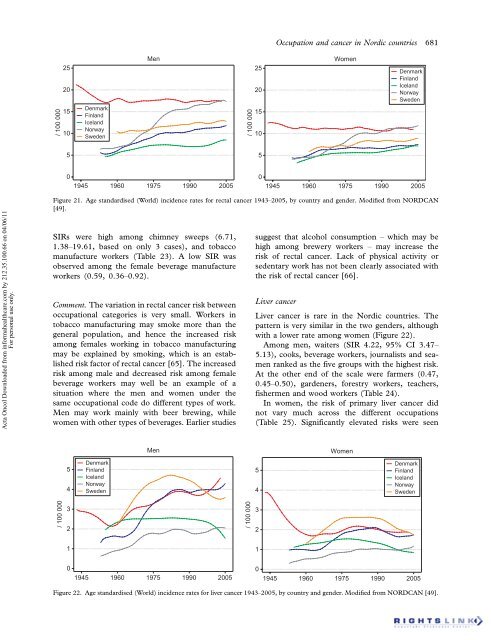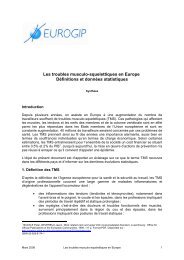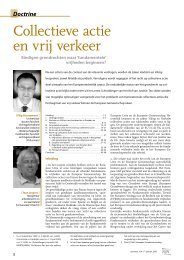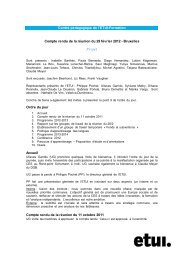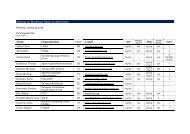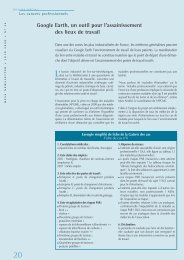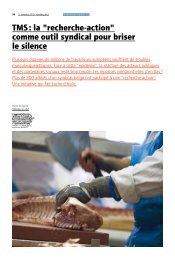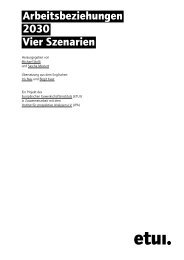Occupation and cancer - European Trade Union Institute (ETUI)
Occupation and cancer - European Trade Union Institute (ETUI)
Occupation and cancer - European Trade Union Institute (ETUI)
Create successful ePaper yourself
Turn your PDF publications into a flip-book with our unique Google optimized e-Paper software.
Acta Oncol Downloaded from informahealthcare.com by 212.35.100.66 on 04/06/11<br />
For personal use only.<br />
/ 100 000<br />
25<br />
20<br />
15<br />
10<br />
5<br />
Denmark<br />
Finl<strong>and</strong><br />
Icel<strong>and</strong><br />
Norway<br />
Sweden<br />
Men<br />
0<br />
1945 1960 1975 1990 2005<br />
SIRs were high among chimney sweeps (6.71,<br />
1.38 19.61, based on only 3 cases), <strong>and</strong> tobacco<br />
manufacture workers (Table 23). A low SIR was<br />
observed among the female beverage manufacture<br />
workers (0.59, 0.36 0.92).<br />
Comment. The variation in rectal <strong>cancer</strong> risk between<br />
occupational categories is very small. Workers in<br />
tobacco manufacturing may smoke more than the<br />
general population, <strong>and</strong> hence the increased risk<br />
among females working in tobacco manufacturing<br />
may be explained by smoking, which is an established<br />
risk factor of rectal <strong>cancer</strong> [65]. The increased<br />
risk among male <strong>and</strong> decreased risk among female<br />
beverage workers may well be an example of a<br />
situation where the men <strong>and</strong> women under the<br />
same occupational code do different types of work.<br />
Men may work mainly with beer brewing, while<br />
women with other types of beverages. Earlier studies<br />
/ 100 000<br />
25<br />
20<br />
15<br />
10<br />
5<br />
Women<br />
Denmark<br />
Finl<strong>and</strong><br />
Icel<strong>and</strong><br />
Norway<br />
Sweden<br />
0<br />
1945 1960 1975 1990 2005<br />
Figure 21. Age st<strong>and</strong>ardised (World) incidence rates for rectal <strong>cancer</strong> 1943 2005, by country <strong>and</strong> gender. Modified from NORDCAN<br />
[49].<br />
/ 100 000<br />
5<br />
4<br />
3<br />
2<br />
1<br />
0<br />
Denmark<br />
Finl<strong>and</strong><br />
Icel<strong>and</strong><br />
Norway<br />
Sweden<br />
Men<br />
1945 1960 1975 1990 2005<br />
/ 100 000<br />
suggest that alcohol consumption which may be<br />
high among brewery workers may increase the<br />
risk of rectal <strong>cancer</strong>. Lack of physical activity or<br />
sedentary work has not been clearly associated with<br />
the risk of rectal <strong>cancer</strong> [66].<br />
Liver <strong>cancer</strong><br />
Liver <strong>cancer</strong> is rare in the Nordic countries. The<br />
pattern is very similar in the two genders, although<br />
with a lower rate among women (Figure 22).<br />
Among men, waiters (SIR 4.22, 95% CI 3.47<br />
5.13), cooks, beverage workers, journalists <strong>and</strong> seamen<br />
ranked as the five groups with the highest risk.<br />
At the other end of the scale were farmers (0.47,<br />
0.45 0.50), gardeners, forestry workers, teachers,<br />
fishermen <strong>and</strong> wood workers (Table 24).<br />
In women, the risk of primary liver <strong>cancer</strong> did<br />
not vary much across the different occupations<br />
(Table 25). Significantly elevated risks were seen<br />
5<br />
4<br />
3<br />
2<br />
1<br />
0<br />
<strong>Occupation</strong> <strong>and</strong> <strong>cancer</strong> in Nordic countries 681<br />
Women<br />
Denmark<br />
Finl<strong>and</strong><br />
Icel<strong>and</strong><br />
Norway<br />
Sweden<br />
1945 1960 1975 1990 2005<br />
Figure 22. Age st<strong>and</strong>ardised (World) incidence rates for liver <strong>cancer</strong> 1943 2005, by country <strong>and</strong> gender. Modified from NORDCAN [49].


